嘉義街景
為提供使用者有文書軟體選擇的權利,本文件為ODF開放文件格式,建議您安裝免費開源軟體 ([連結])
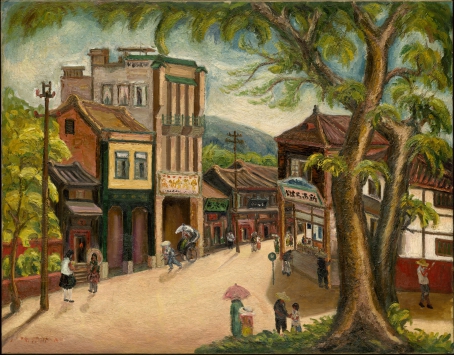
嘉義街景
Chiayi Street Scene
嘉義の町
1934, 畫布油彩, 91×116.5cm
oil on canvas
画布油彩
新式樓房矗立在市街當中,與鄰近的木頭房子、傳統店屋形成有趣的對比。建築物的周圍,陽光徐徐降落,在地面上鋪成大片的暖黃。沐浴在溫熱的光線裡,畫中的一切景物也映現出和煦可愛的顏色。近景一株大樹伸展成蓬幕,彷彿要為街上的人群提供遮蔭。閉上眼睛,試著走進陳澄波的畫境裡,或許,你也能觸摸到屬於這片土地的溫度。
A modern office building rises above the city street, creating an interesting contrast with the surrounding wooden houses and traditional storefronts. Around the building, rays of light begin to softly illuminate the scene, paving the street with a warm, yellow glow. A tall tree in the foreground stretches open its branches to form a curtain of leafy shade, as if to offer passersby respite from the brilliant heat. If you try to imagine yourself walking down this Chiayi street, perhaps its warmth will envelop you, too.
新しい様式の建物が立ち並ぶ市街地、その隣に立つ木造家屋や伝統的な店舗がおもしろい対比をなしています。建物周囲に穏やかに降り注ぐ陽光で、あたり一面が暖かな黄色に染まっています。柔らかい陽射しを浴びて、画中に描かれた全ての景物も温もりある愛らしい色となっています。近景の大木が枝を広げ、路上の人たちに木陰を提供しているかのようです。目を閉じて陳澄波の絵の世界を歩いてみれば、この土地の温度に触れることができるかもしれません。
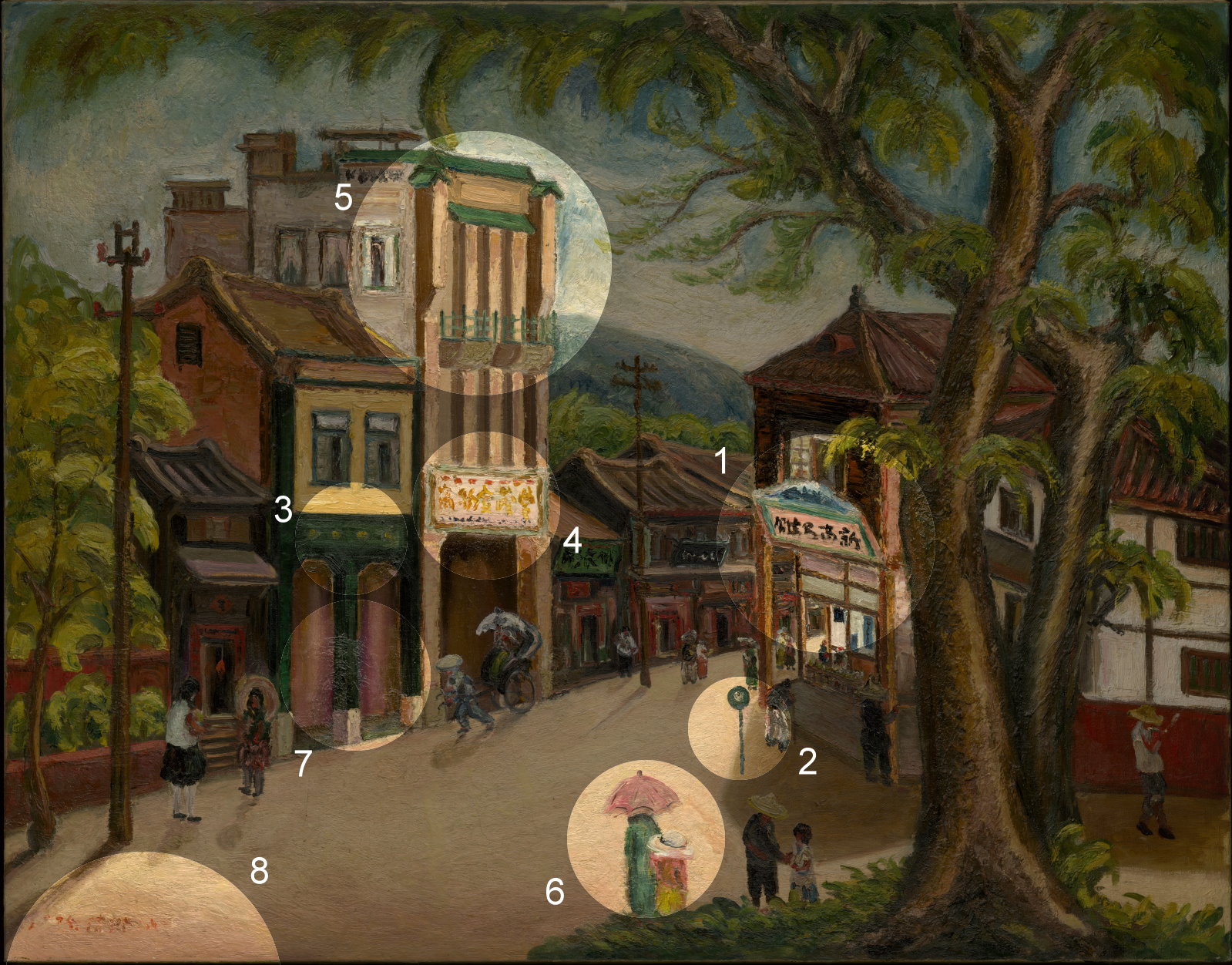
1.新高寫真館
Mount Jade Photo Studio
新高写真館
1927年,來到嘉義創業的攝影師方慶綿買下了這間位於街角的照相館,並沿用「新高寫真館」的舊名。方慶綿以山岳攝影聞名,足跡遍及玉山、阿里山、八通關等地,其作品為早期臺灣山岳的自然與人文景象留下珍貴的歷史紀錄。
In 1927, the photographer Fang Qing-mian moved to Chiayi to start his own business. He bought the Mount Jade Photo Studio, which was located on the street corner depicted in this painting, and ran the business without changing its name. Renowned for his mountain photography, Fang crisscrossed Taiwan—camera in hand—capturing the beauty of Mount Jade, Alishan, Batongguan, and other stunning peaks. To this day, his work lives on as a remarkable tribute to the natural mountain landscapes and culture of early Taiwan.
1927年、嘉義に来て創業した写真家・方慶綿氏がこの街角の写真館を買い、旧店名の「新高写真館」をそのまま店名としました。方氏は山岳写真家として知られ、玉山や阿里山、八通関山などを踏破しました。方氏の作品は、往時の台湾山岳地帯の自然や文化を写真として留め、歴史的に貴重な記録となっています。
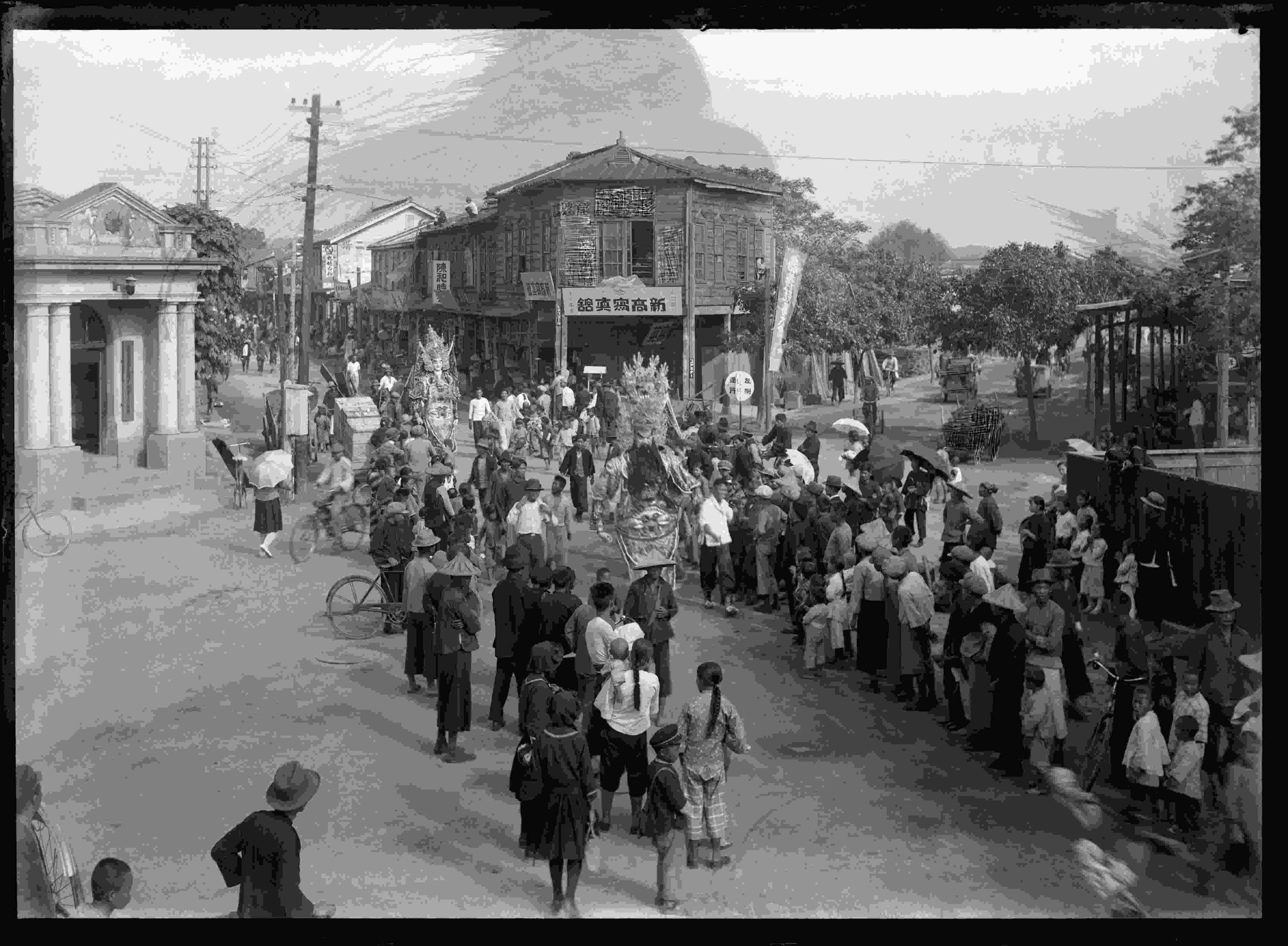
1.玉山國家公園管理處
2.作者:方慶綿,子-方重雄先生提供
盧添登編撰,《穿越時空玉見您》(水里鄉:玉山國家公園,2010),頁86。玉山國家公園管理處授權。
Lu Tian-deng, editor. Meeting Yushan Through Time and Space. Shuili Township: Yushan National Park, 2010, pp. 86.
盧添登編纂,『穿越時空玉見您』(水里郷:玉山国家公園,2010),p.86。
2.「左側通行」立牌
“Traffic keeps left” signpost
「左側通行」の立て札
左側通行是日本政府從本國輸入臺灣的現代化交通規則。透過街上的立牌、巡查的道路指揮、學校教育的宣導等各種方式,總督府在民間積極推行此一政策,但成效有限。戰後,臺灣順應中華國民政府的法令,又改為右側通行。
The practice of driving on the left side of the road was established in Taiwan by the Japanese colonial government. The Governor-General’s Office actively sought to implement this policy on a local level with traffic signs, traffic controllers, and school campaigns among other means, but was met with limited success. After the war, conforming to traffic regulations introduced by the Republic of China, it once again became customary in Taiwan to drive on the right side of the road.
「左側通行」は日本政府が台湾に持ち込んだ近代的な交通ルールです。総督府は路上の立て札や交通整理をする巡査、学校教育による指導など、様々な手法でこの政策を民間に根付かせるべく積極的に推進しましたが、その効果には限界がありました。戦後、台湾では中華国民政府の法令に従って、右側通行に改められました。
3.永利商店
Yong Li Store
永利商店
兩層樓建築的綠色拱門上方,四個立體字的招牌寫著「永利商店」,這是一間專門販售各種金屬材料與機械工具的商行。有空的話,不妨到嘉義市區的興中街與中正路口尋訪陳澄波的畫中場景,這棟房子是今日唯一存在的景物。
Above the green arched doorway of a two-story building, four block Chinese characters read “Yong Li Store.” This trading company specialized in selling a variety of metal parts, tools, and machinery. If you ever find yourself in Chiayi with a moment to spare, you might enjoy stopping by the intersection of Xingzhong Street and Zhongzheng Road. You’ll find that out of all the buildings which appear in this painting, the only one still standing is the old Yong Li Store.
2階建ての建物の入口に緑色のアーチがあります。その上に看板があり、立体的な文字で「永利商店」と記されています。この店は、各種金属素材や機械工具を専門に売る店でした。もしお時間があれば、陳澄波の絵に描かれた嘉義市内の興中街と中正路の十字路付近を訪れてみてください。画中の景物の中で唯一現存するのがこの建物です。
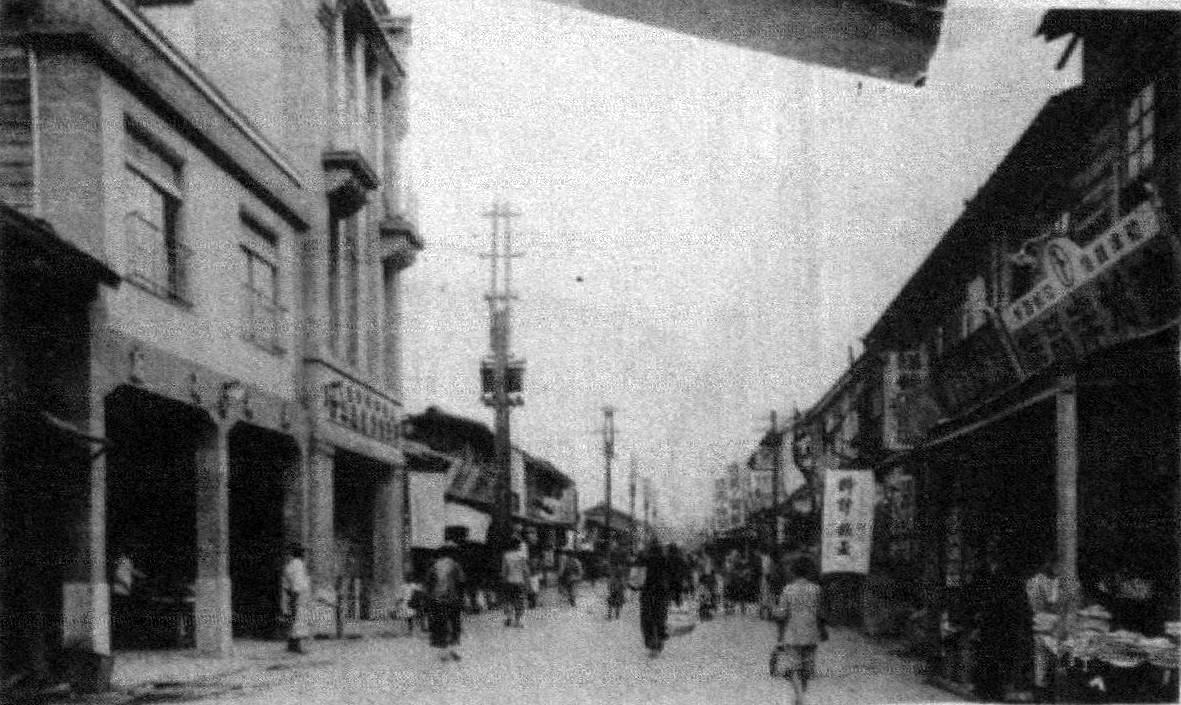
嘉義市役所,《嘉義市制五周年記念誌》(嘉義:嘉義市役所,1935),前置面22,〈本島人街〉。國立臺灣大學授權。
Chiayi City Hall. Chiayi City Fifth Anniversary Review. Chiayi: Chiayi City Hall, 1935, pp. xxii, Native Islanders Street.
嘉義市役所,『嘉義市制五周年記念誌』(嘉義:嘉義市役所,1935),前置きp.22,「本島人街」。
http://photo.lib.ntu.edu.tw/pic/db/detail.jsp?dtd_id=32&id=27086&1&pk=seq&showlevel=2
4. 豐茂金物商
Fengmao Hardware Store
豊茂金物商
偌大一塊招牌寫著「豐茂金物商」,這間由嘉義聞人羅茂松家族所經營的企業,在1930年代不斷擴張規模,並於高雄設立支店。除了經營鋼鐵建材與各類金屬的買賣,該公司還在北社尾成立工廠,製作石綿煙囪與雞舍鐵網等產品。
Operated by the family of prominent local figure Luo Mao-song, the Fengmao Hardware Store was easily identifiable by the large shop sign over its doorway. At its outset, the company dealt in steel building materials and assorted metal goods. As Fengmao continued to expand its operations during the 1930s, it opened a branch in Kaohsiung. The company also opened a factory in Chiayi’s Beishewei neighborhood which produced various goods, including asbestos-lined chimney flues and chain link fencing for chicken coops.
ひと際大きな看板に「豊茂金物商」という文字が見えます。この建物は嘉義の名士・羅茂松氏とその一族が経営する企業の店舗で、1930年代に事業規模を拡げ、高雄にも支店を出しました。鋼鉄建材や各種金属の売買のほか、北社尾に工場も建設し、石綿を使った煙突や鶏舎の金網などを製造していました。
蘇睦喬總編輯,《嘉義寫真‧第二輯》(嘉義市:嘉義文化局,2002),頁25。嘉義市政府文化局授權。
Su Mu-qiao, editor. Photography about Chiayi City, vol. 2. Chiayi: Chiayi Cultural Affairs Bureau, 2002, pp. 25.
蘇睦喬編,『嘉義写真・第二集』(嘉義市:嘉義文化局,2002),p.25。
5.嘉義市的新地標
Chiayi’s new landmark
嘉義市の新しいランドマーク
三層樓的鋼筋水泥建築落成於1934年,這是豐茂商行的事務所,也是當年嘉義前所未見的市街建築。陳澄波的道路風景畫,時常注意現代文明所帶來的景觀改造成果。這棟造型奇特的房子,或許就是驅使他創作這幅畫的主要原因。
Completed in 1934, the three-story reinforced concrete building housed the business offices of the Fengmao Trading Company. At the time, it was a structure the likes of which had never before been seen in the streets of Chiayi. Chen Cheng-po’s streetscape paintings often draw attention to the spectacular ways in which modern civilization was changing cities and skylines. Thus, the distinctive architecture of this building may have been what sparked Chen’s interest in painting this scene.
3階建ての鉄筋コンクリートの建物は1934年に落成しました。この建物は豊茂商店の事務所で、当時の嘉義ではかつてないほどの都会的な建築物でした。陳澄波が描く道の風景画においては、現代文明がもたらした景観改造の成果に、いつも注意が払われています。この斬新なデザインの建物が、陳澄波を作画に駆りたてた主な理由かもしれません。
6. 素描
Sketches
デッサン
就目前所見,陳澄波針對這幅畫裡的景物,至少製作了三件鉛筆速寫。比較這些作品,我們可以發現他曾經試圖移動視點,使用垂直畫幅,或取消右側的大樹。不變的是,他始終注意安排背景的山巒,以及前景人物的親情互動。
Chen completed at least three pencil sketches of the street corner depicted in this painting. It’s interesting to look at the sketches altogether because they reveal how Chen experimented with different elements, such as shifting the vantage point, using a vertical instead of horizontal canvas, and eliminating the tree on the righthand side. Within these sketches, two things that remain constant are the inclusion of the mountains in the background and the figures, interacting amicably, in the foreground.
陳澄波はこの絵の風景を描くために、少なくとも3枚の鉛筆スケッチを残しています。これらの絵を比較してみると、縦に長い紙を使い、右側の大木を消すなどして、画家が視点を移動させようと試みていたことに気づきます。変わらないのは、常に背景の山々の配置に気を配っている点と、前景の人物たちの親しげな様子です。
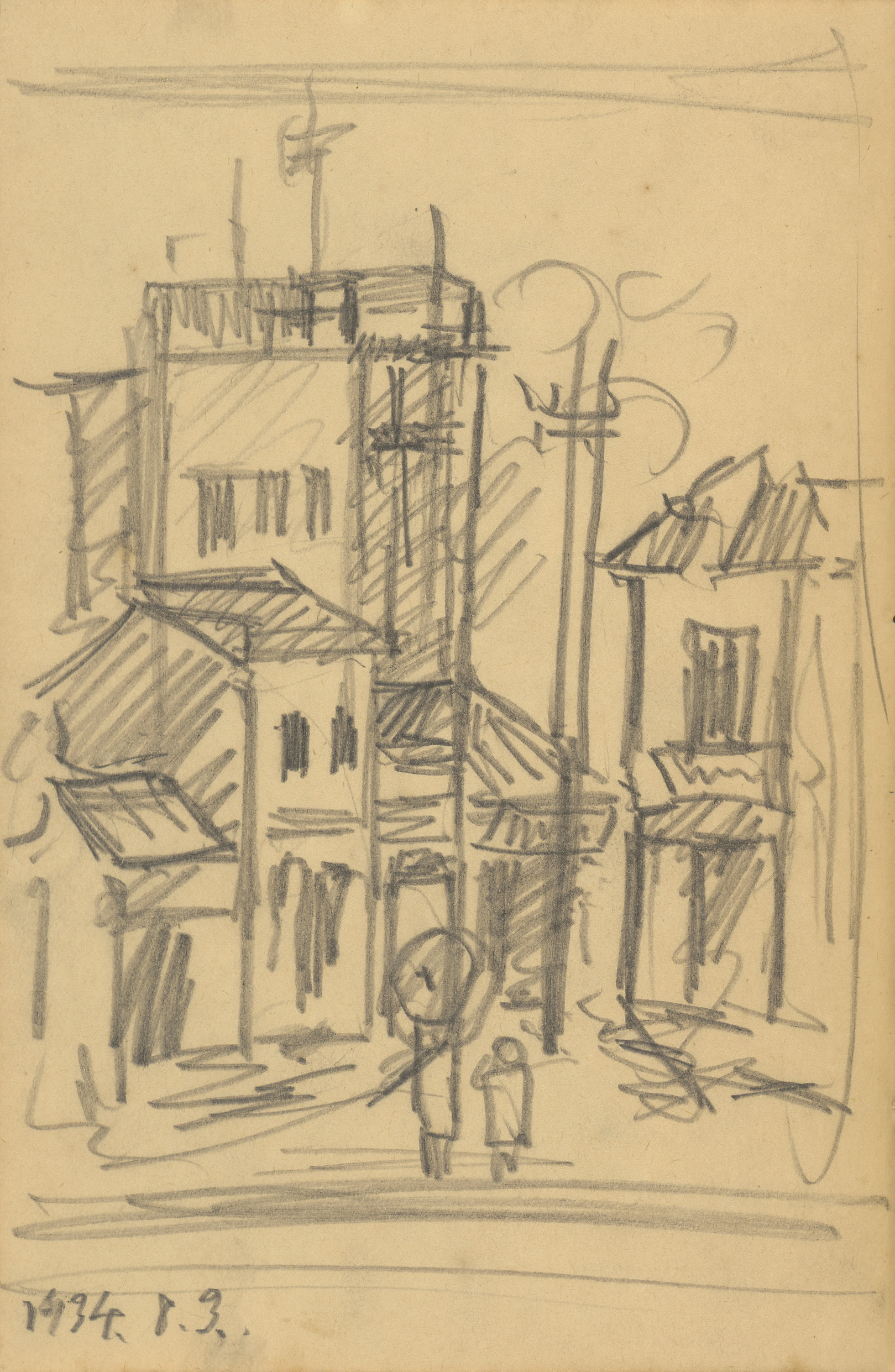

風景速寫(107)-SB13:34.8.3 1934 紙本鉛筆 18×12cm
Landscape Sketch-SB13:34.8.3 1934 Pencil on paper 18×12cm
風景のスケッチ(107)-SB13:34.8.3 1934 紙、鉛筆 18×12cm
SB13-098 風景速寫(108)-SB13(33.5-34.9)約1933-1934 紙本鉛筆 18×12cm
Landscape Sketch-SB13(33.5-34.9) ca. 1933-1934 Pencil on paper 18×12cm
風景のスケッチ(108)-SB13(33.5-34.9) 1933-1934頃 紙、鉛筆 18×12cm

風景速寫-34.8.3(2) 1934 紙本鉛筆 19.1×25.5cm
Landscape Sketch-34.8.3 (2) 1934 紙本鉛筆 19.1×25.5cm
風景のスケッチ-34.8.3 (2) 1934 紙、鉛筆 19.1×25.5cm
7.亭仔腳(tîng-á-kha)
Streetside arcades (tîng-á-kha)
亭仔脚(tîng-á-kha)
騎樓是流行於中國南方與東南亞地區的建築型制,在高溫多雨的氣候環境裡,街屋前的走廊可以為行人提供遮蔽。日治時期嘉義市區的現代化建設過程中,「亭仔腳」的設置也被政府納入法令,繼而成為熱鬧市街裡的常見景觀。
Streetside arcades offer pedestrians an escape from sweltering heat and rainy weather. As a result, this architectural design became popular across southern China and southeast Asia, regions well-known for their hot and rainy climates. During the Japanese era, Chiayi’s local government mandated the construction of streetside arcades as part of a municipal renovation project. From that point on, these spaces became a common sight lining the city’s lively streets.
「騎楼」は中国南方や東南アジアで流行した建築様式です。高温多雨の地域では、商店前の通路を歩けば、雨や陽射しを避けられるようになっています。日本統治時代の嘉義市内で進められた、近代化に向けての建設工事では、「亭仔腳」(騎楼)の設置も政府の法令に盛り込まれたことから、「騎楼」はにぎやかな市街地でよく見かける景観の一つとなりました。
8.修復倫理
The principles of art restoration
修復における倫理
與其他許多陳澄波的油畫相仿,《嘉義街景》也曾接受修復工程。畫作左下角地面的顏料原已大片掉落,主事的木島隆康教授秉持著藝術修復的倫理原則,補上相似並具有可逆性的油彩,讓修補的痕跡與陳澄波的手筆和諧並存。
As with several of Chen’s other oil paintings, Chiayi Street Scene has undergone careful artistic restoration. On the lower left side of the canvas, paint had begun to peel off in large flakes. In line with art conservation principles, Professor Kijima Takayasu touched up the area with a removable paint which was similar in color to the original, seamlessly blending in the traces of restoration with the artist’s own brushstrokes.
陳澄波の多くの油彩画と同様に、この『嘉義の町』も修復されたことがあります。左下角の地面の色が大きく剥落していましたが、主導した木島隆康教授の美術品修復における倫理的原則に基づき、本来使われていたものに近く、可逆性のある油彩を使って修復され、陳澄波のタッチと修復跡は違和感もなくしっくりとなじんでいます。
